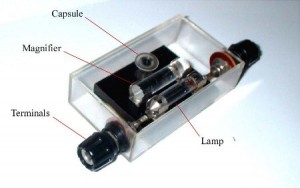-
Brownian Motion
Posted on March 31st, 2010 No commentsAnother part of the physicists file of silly hypotheses. Taught with much enthusiasm in schools, colleges and universities around the world, (mainly due to Einstein’s interpretation of its meaning), it consists of a small capsule full of liquid with a small quantity of pollen grains mixed in it. Observation of the mixture shows the pollen grains constantly on the move. Einstein claimed that this proved that molecules were in a constant state of movement on their own accord, and this molecular movement caused the pollen grains to move.
What was ignored, was that to see the pollen grains a high intensity beam of light was projected into the capsule. In my own Brownian Motion unit (Above), I estimate that between 350 and 500 watts of energy per litre of liquid are injected into the capsule, sufficient to boil away the liquid in a very short time. It is this energy injection that causes the movement of the pollen grains, not an inherent vibration of the molecules.
Einstein carried this strange hypothesis into his hypotheses regarding the gas laws, which further retarded the advancement of physics.
Short abstract from Physics or Fantasy – Section 2- Colour and the Quantum Theory – Brownian Motion.
Author – Brian Williams
-
Printer Colours
Posted on March 16th, 2010 No commentsThe printer colour cartridges Yellow, Magenta, and Cyan, are actually pale Yellow, pale Red ( Although some do have a small percentage of Blue) and pale Blue. They depend on the White of the paper and Black to create the various colour approximations.
In the lighter Yellow range control is by reducing the ratio of Yellow spots to allow more White to show through. In the darker Yellow range control is by adding varying ratios of Red or Black spots. If only Black spots are added it gives an impression of a darker Yellow, but if Red is added it gives an Orange/Yellow Ochre impression which people still consider to be Yellow. An artist will tell them differently.
In the lighter Red range control is by reducing the ratio of Red spots to allow more White to show through. In the darker Red range control is by adding varying ratios of Blue or Black spots.
In the lighter Blue range control is by reducing the ratio of Blue spots to allow more White to show through. In the darker Blue range control is by adding varying ratios of Red or Black spots. Black only gives a darker Blue.
Red only gives such Blues as Royal Blue etc. which have a higher energy than ‘true’ Blue.
Many papers have a distinct Yellow tint, and the White energy of ambient light, both affect our viewing of the finished print.


